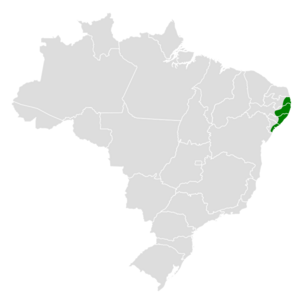Pernambuco foliage-gleaner facts for kids
Quick facts for kids Pernambuco foliage-gleaner |
|
|---|---|
 |
|
| Conservation status | |
| Scientific classification | |
| Genus: |
Automolus
|
| Species: |
lammi
|
 |
|
| Synonyms | |
|
Automolus leucophthalmus lammi |
|
The Pernambuco foliage-gleaner (Automolus lammi) is a special bird. It belongs to the ovenbird family. This bird is currently listed as an Endangered species. This means it is at high risk of disappearing. It lives only in a small area of northeastern Brazil.
Contents
Discovering the Pernambuco Foliage-Gleaner
For many years, scientists thought this bird was just a subspecies. It was believed to be a type of the white-eyed foliage-gleaner. But in 2008, new research changed that view. Scientists decided it was unique enough to be its own species.
This bird is part of a "superspecies" group. This means it's very closely related to a few other birds. These include the white-eyed, olive-backed, and Para foliage-gleaners.
What Does This Bird Look Like?
The Pernambuco foliage-gleaner is about 19 to 20 cm (7.5 to 7.9 in) long. That's about the size of a large robin. It has a strong, heavy bill. Both male and female birds look alike.
Their face is dark brownish. They have faint reddish streaks near their ears. The area around their eyes is reddish-brown and buffy. Their cheeks are white. The top of their head is dark brown with thin reddish streaks.
Their back and rump are dark brown. These colors blend into reddish-brown feathers near their tail. Their wings are dark reddish-brown. The tail is a bright reddish-brown color.
Their throat and neck sides are white with a yellow tint. This color sharply contrasts with their creamy olive-buff chest and belly. The sides of their chest are brownish. Their under-tail feathers are pale reddish-brown. This bird has whitish eyes. Its bill is dark, and its legs and feet are grayish.
Where Does the Pernambuco Foliage-Gleaner Live?
This bird is found only in a specific part of Brazil. This area is called the Pernambuco Center of Endemism. It includes the states of Paraíba, Pernambuco, Alagoas, and Sergipe.
It prefers to live in tropical evergreen forests. It also lives in older secondary forests. These are forests that have regrown after being cut down. You can find them from near sea level up to about 550 m (1,800 ft) high.
How Does This Bird Behave?
Daily Life and Movement
The Pernambuco foliage-gleaner stays in the same area all year. It does not migrate.
What Does It Eat?
Scientists don't know much about what this bird eats. But they do know it eats arthropods. These are creatures like insects and spiders.
It often forages with other bird species. They form what's called a mixed-species feeding flock. This means different types of birds hunt for food together. The foliage-gleaner usually stays low in the dense forest. It pulls its food from dead leaves, debris, and plants growing on trees.
Reproduction and Life Cycle
Sadly, not much is known about how the Pernambuco foliage-gleaner breeds. Scientists are still learning about its nesting habits and how it raises its young.
What Does It Sound Like?
The song of the Pernambuco foliage-gleaner is special. It helps tell it apart from other similar birds. Its song is a loud series of 2 to 11 notes. These notes are harsh and grating. Each note might be a double sound.
Its call is a loud "weck" sound. It can repeat this sound up to 20 times. It also makes "kwek" and "kwek-kwaah" calls. These sounds are similar to those made by the white-eyed foliage-gleaner.
Why Is This Bird Endangered?
The IUCN first listed this bird as Vulnerable in 2014. But in 2017, its status was changed to Endangered. This means it's in even greater danger.
There are only an estimated 1,000 to 2,500 adult birds left. This number is believed to be shrinking. The main reason is the loss of its forest home. Forests have been cut down for farming, especially for sugar cane. Most of the remaining forests are small, separate pieces.
Even in protected areas, there are problems. Some reserves, like Murici Ecological Reserve, suffer from illegal logging. This means trees are being cut down illegally. Protecting these forests is very important for the future of the Pernambuco foliage-gleaner.


